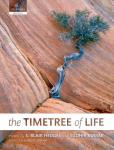Over a hundred authors, including
molecular phylogeneticists, systematists,
and paleontologists, contributed
to The Timetree of Life,
which its editors say is the first volume
to publish calibrated divergence
times against phylogenies
for all major groups of living
things. The results are truly impressive
reviews of the histories and
current knowledge of molecular
and other determinations of when
the major groups of living things
diverged from each other.
authors, including
molecular phylogeneticists, systematists,
and paleontologists, contributed
to The Timetree of Life,
which its editors say is the first volume
to publish calibrated divergence
times against phylogenies
for all major groups of living
things. The results are truly impressive
reviews of the histories and
current knowledge of molecular
and other determinations of when
the major groups of living things
diverged from each other.
In assembling this book, the authors submitted to certain conventions. Alternate phylogenies are not considered. Only timetrees based on molecules are used. The editors say that only one kind of molecule needs to be used, and that it doesn’t have to be independently validated by other (including non-molecular) lines of evidence. If different molecules give different divergence estimates, the estimates are to be averaged. (This strikes me as strange, inasmuch as it equally values or doubts all studies, rather than asking questions about the reliability of certain molecules or studies over others.) In fact, the editors in particular seem to be glossing over a lot of legitimate debate and cognitive dissonance, which seems odd for a scientific book.
For example, in their opening chapter the editors reject fossil evidence as reliable for estimating divergence times. Instead, they advocate “associated geological dates,” an approach first proposed by Charles Sibley in the 1970s and quickly discredited. (What is the “date” of the opening of the Atlantic Ocean?) They give the emergence of islands as good events by which to calibrate divergence times. But what major groups of organisms first diverged on islands? The editors actually don’t give a single example of a reliable “geologic event” that can calibrate molecular phylogenies.
The editors state that “fossil calibrations are always minimum times of divergence,” which would be true if one simply used the first recorded appearance of a member of a stem or node group. More reliable is the assessment of the timing of appearances of characters that are diagnostic of that group. Let’s say that node group A shares derived features 1–5, and that its immediate relatives can be recognized because they have progressive subsets of 1–5 (for example, one critter has 1, another has 1 & 2, and so on). Knowing when these immediate relatives lived provides very strong control on divergence dates based on fossils. Of course, the fossil record may not be good enough to decide these questions in the great majority of cases. On the other hand, unconstrained extrapolations from molecular differentiation rates, with no independent lines of evidence to test them, are technologically impressive but empirically unsatisfactory.
It is interesting that the other introductory chapters disagree with the editors’ methods. John Avise forthrightly extols the use of fossils to calibrate divergence times. Gradstein and Ogg lay out the geologic time scale and the important certainties and uncertainties in its calibration. Benton, Donoghue, and Asher, all paleontologists, in a particularly impressive review (with over 500 references) show how using both fossils and molecules in tandem can produce reliable results for much of the phylogeny of Metazoa.
So the editors seem to be broadminded in including eclectic approaches to assembling the timetrees of life. It is too bad, then, that the prescriptions of Benton and others are not followed throughout the book. Some entries induce head-scratching. Van Tuinen (p 409), for example, says that the two major groups of living birds (paleognaths and neognaths) separated about 120 Ma, whereas Benton and his coauthors list it at about 66 Ma (“soft maximum” dates are often ridiculously old and can generally be disregarded). Here is an example of where a character-based approach to fossils may help constrain molecular estimates. If one examines the fossil record of birds about 120 Ma, and even later in the Cretaceous, what do we find? Well, the fossil birds found in the Jehol Biota of China (Early Cretaceous, about 125 Ma), where the famous “feathered dinosaurs” are also found, include things like Confuciusornis that are hardly advanced beyond Archaeopteryx. Through the Cretaceous we find thousands of bird fossils, but they are all of primitive toothed groups and Enantiornithines, none of which is regarded as close to Neornithes. More importantly, the morphological features that are in any way similar to those of living birds do not appear until the latest Cretaceous (66–70 Ma). To accept the molecular view of life, molecules are doing the diverging, but this is very seldom reflected in morphology.
Is this a reasonable view of life? Space prohibits a review of the editors’ strange take on rates of diversification of taxa, especially where we have an actual fossil record that is pretty reliable. Suffice it to say that there is forty years of literature on Phanerozoic diversity that cannot be reduced to the unsatisfactory alternatives of “dampened exponential curve” or the “exponential model”. This book will be a fabulous basis for advanced interdisciplinary seminars, but I put the accent on “interdisciplinary”.
